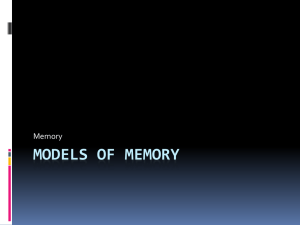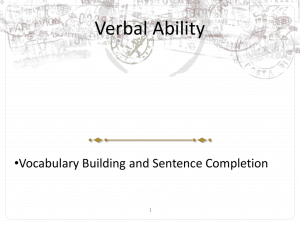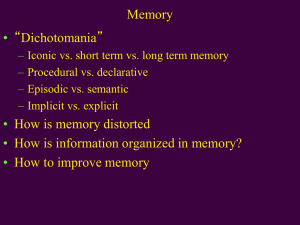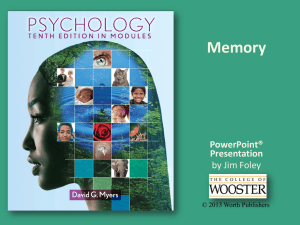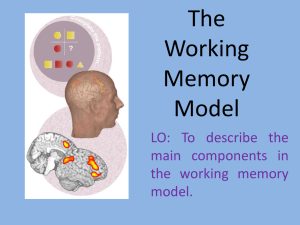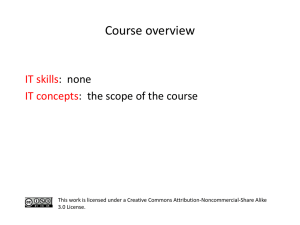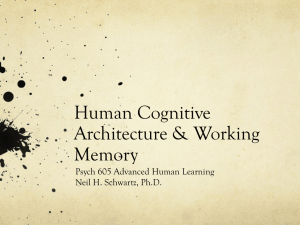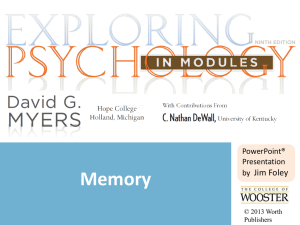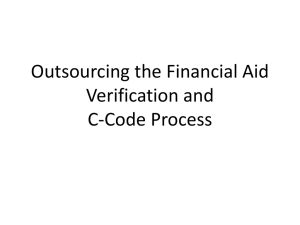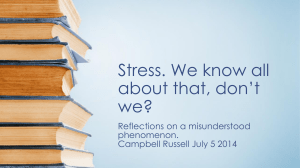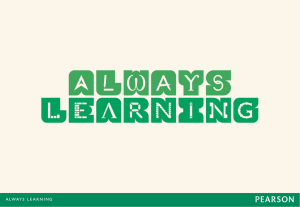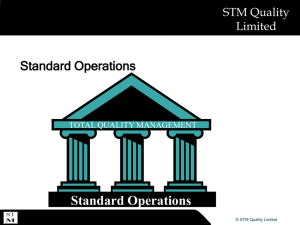Working memory
advertisement
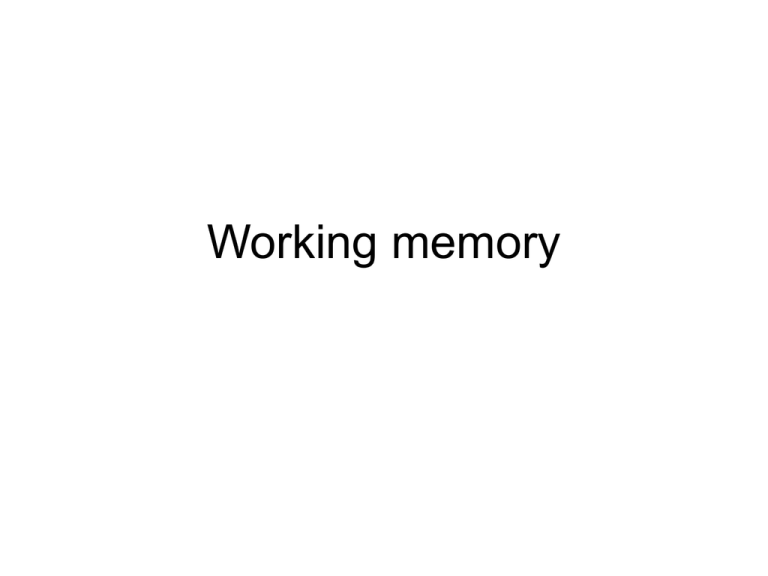
Working memory Traditional Model of Memory • Atkinson & Shiffrin (1968) 3 Stage Model Stimuli Sensory registers Short Term Memory (STM) Information Processing Model Long Term Memory (LTM) What is short-term memory (STM) for? • Is STM for transferring information to longterm memory (LTM)? • Is it a passive terminal for information transfer? Working memory: Conceptual Background Working memory • STM is a temporary storage of information. • STM is a temporary buffer (control center) of information. – Temporary storage • Questions: – From New York to Pittsburgh, it takes about 7hours and 30 minutes by car. From Pittsburgh to Chicago, it takes about 8hours and 30 minutes by car. How long does it take from New York to Chicago, if you want to drive through Pittsburgh? Easy Ah? – Tom is taller than Jane. Jane is shorter than Steve. Lisa is taller than Steve and Tom. And Steve is shorter than Tom. Is Jane shorter than Tom? Raven test Raven test: (Carpenter, Just, & Shell, 1990) (2 x 6) -10 =? 3 + 4 +3 x 3 =? • Do the following calculations while you keep pronouncing “the, the,…” (3 x 5) -10 =? 2 + 5 - 3 x 3 =? Demonstration Task 1 – Find the answer to the following question as quickly and accurately as possible. Lucy came before Jane. Kathy arrived after Jane. Suzy came before Lucy. Who came first? Who came second? Task 2: – Find the answer to the following question as quickly and accurately as possible. While you are looking for the question, please keep saying “the-the-the-the….” Tom arrived after Steve. John came before Steve. Mike arrived before John. Who came first? Who came second? • Bill went to dinner and met Jane. They decide to share their French Fries and coke. After the dinner, they left the cafeteria and spend some time in a library together. After going over some review notes for their Sociology class, they went to the movies together. Later, Steve saw Jane sitting in a lounge and talking with Bill. Are Bill and Jane friends? Temporary storage of information • How do we solve these questions? • In order to answer these questions, you need temporary storage of information. – STM working memory • Working memory a buffer for information manipulation Computer metaphor • Working memory Random Access Memory (RAM) – 128MB • Long-term memory – Hard disk, Zip disk • After shutting down your computer, you lose the information stored in RAM. • But the infor. stored in your hard disk is OK. Do we have RAM (Working memory)? • Do we have working memory as we have RAM in our computer? Operation Span Experiment (CogLab CD) Baddeley’s dual task experiments • Test the idea that short-term memory is not just for transferring information to LTM. • It is for a working buffer (to manipulate information) for many cognitive activities. Working memory • If there is something called “working memory”, what is it? • How does it encode and manipulate information? • How does it transfer information to LTM? • What is the capacity? (128MB?) Hypothesis We use Short-term memory for Working memory Baddeley’s experiments: • Procedure 1 (control condition): – The subject was given items to remember (e.g., a sequence of numbers or letters) – The subject report the item given in the first task (recalling). – The subject carried out a cognitive task (e.g., verifying a sentence) • Procedure 2 (Experimental condition): – The subject was given items to remember (e.g., a sequence of numbers or letters) – The subject carried out a cognitive task (e.g., verifying a sentence) – The subject report the item given in the first task (recalling). • (Baddeley & Hitch, 1974) Design: Control condition Experimental condition Memory encoding Memory encoding Memory retrieval (recall) A sentence verification task A sentence verification task Memory retrieval (recall) Tasks: • Memory task: – Briefly present a list of digits (414321090) to the subject. – The subject recalls the digits as accurately as possible. • Sentence verification task: – A is preceded by B. AB? yes/no – C follows D. DC? yes/no Experimental Condition Memorize 756923 A is preceded by B. AB Yes or No? Recall the number Memorize 182732 D comes before C. CD Yes or No? Recall the number Memorize 672392 Memorize 108223 Q follows J. QJ Yes or No? B is before T. TB Yes or No? Recall the number Recall the number Memorize 094722 D is ahead of A. DA Yes or No? Recall the number Memorize 33598 E appears before O OE Yes or No? Recall the number Control Condition Memorize 238646 T is preceded by I. IT Yes or No? Recall the number Memorize 521890 D comes before U. UD Yes or No? Recall the number Memorize 589886 Memorize 332189 Q follows N. NQ Yes or No? B is before Y. YB Yes or No? Recall the number Recall the number Memorize 122649 D is ahead of O. DO Yes or No? Recall the number Memorize 443284 E appears after C CE Yes or No? Recall the number What is the difference between the two conditions? • The memory task is divided by the verification task in the experimental condition. • The memory task is not divided by the verification task in the control condition. Why is this difference important? • Test: – Short-term memory is used as working memory. What is the implication of these, given the experimental design? • In the experimental condition, – you need to hold memory items in your short-term memory while answering the verification questions. • In the control condition, – you don’t need to store memory items while answering the verification questions. Dependent Measure: • Accuracy/response time for the verification task – What results would you expect if Baddeley’s hypothesis is correct? • Hint (computer metaphor). – If you open lots of programs in your computer, what happens? So what? • RAM is filled with lots of information. – E.g., Excel, Words, Photoshop, Netscape, Eudora, ……. • Each operation gets very cumbersome (slow). Baddeley’s hypothesis: • If short-term memory is something to do with temporary manipulation of information (solving math problems, reasoning, etc.), – Then performance for the verification task should decline in the experimental condition, as compared to the controlled condition. Results: • Control condition vs. Experimental condition – Subjects in the Experimental condition were less accurate than subjects in the Control condition. – They also required longer time to make decision. • Mean reasoning time: – Control 2.73 sec – Experimental 4.75 sec Similar results were found in other tasks: – Sentence comprehension, grammar judgment, and problem solving tasks. Interpretations: • Why longer response time required in the experimental condition? – The experimental condition and the control condition differed only in one aspect. • The verification task was given while carrying out the memory task. • The short-term memory task and the sentence verification task required the same temporary storage (buffer) space. Working memory • Short-term memory is “working memory.” • It is a temporary storage for manipulating information. • Working memory is required to perform many cognitive tasks (reasoning, problem solving, language comprehension, etc.). Encoding format of working memory • What is the encoding format of working memory? – == the encoding format of short-term memory. – Auditory (verbal ) encoding • Conrand’s confusion matrix. – auditory rehearsing sends information stored in working memory to long-term storage. Demonstration Task 1 – Find the answer to the following question as quickly and accurately as possible. Lucy came before Jane. Kathy arrived after Jane. Suzy came before Lucy. Who came first? Who came second? Task 2: – Find the answer to the following question as quickly and accurately as possible. While you are looking for the question, please keep saying “the-the-the-the….” Tom arrived after Steve. John came before Steve. Mike arrived before John. Who came first? Who came second? Verbalization hampers the task performance • Why? • Because the capacity of working memory is limited. • The verbalization (the-the-the-…) left little room for the sentence verification task. Working memory (Baddeley, 1986, 1992) • Working memory consists of 3 components – Central executive, phonological loop, visuospatial sketchpad – Phonological loop: • Hold acoustic information (verbal rehearsal) • (sound card?) – Visuospatial sketchpad • Hold visual and spatial information • E.g., mental rotation – Central executive • Allocate attention, coordinate subsytems Working memory • Working memory is related to many cognitive activities. – reading comprehension, solving problems, acquiring new vocabulary... Working memory and learning new words in children • Gathercole and Baddeley (1989) • Subjects: – Children (4-5yrs old) • Test1: – measure their cognitive abilities • general intelligence, reading ability, non-verbal cognitive skills… • Test 2 (non-word repetition task): – the experimenter read aloud non-word syllables (e.g., “mashpole,” “woop” “kintent.” ) to children. Then, children were asked to repeat the syllables. – Children’s ability to repeat the syllables was scored. • Test 3 – 1 yr later, the experimenter measured children’s vocabulary score (majoring roughly the number of new words these children acquired in a year). • Results: – children’s verbalization ability (as measured by their ability to repeat nonword syllables) correlated with their vocabulary acquisition score. – ---> • children’s verbalization ability is related to their ability to acquire new words.

